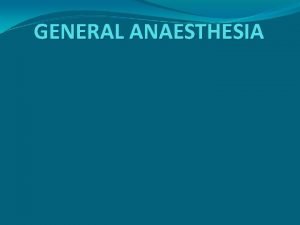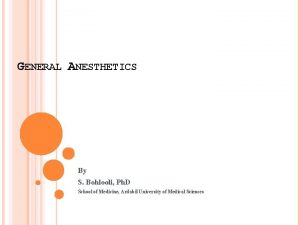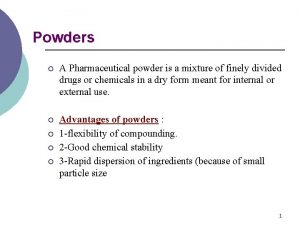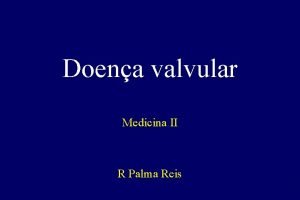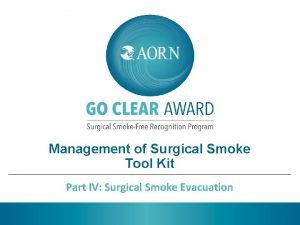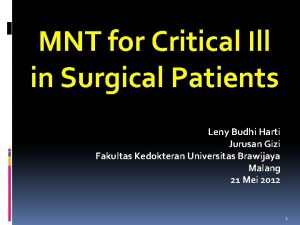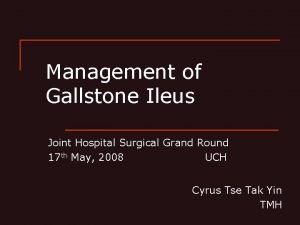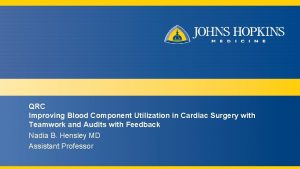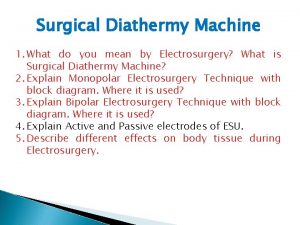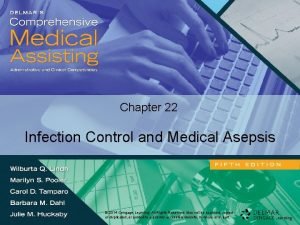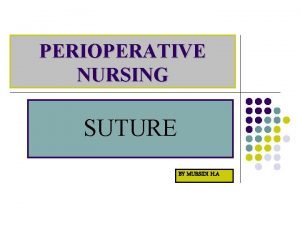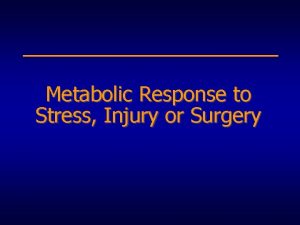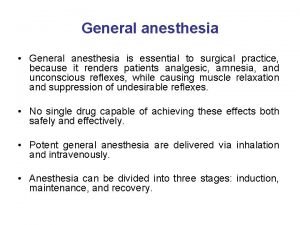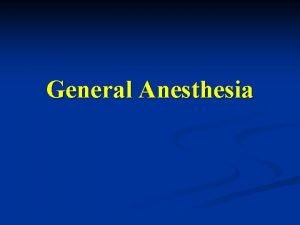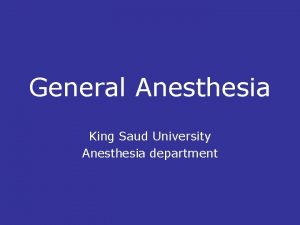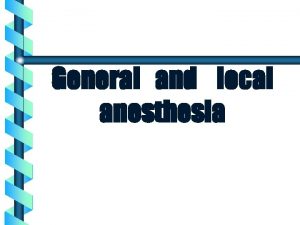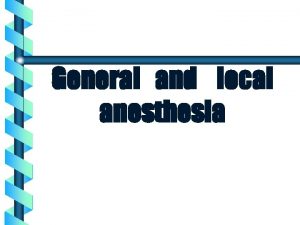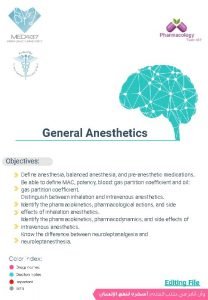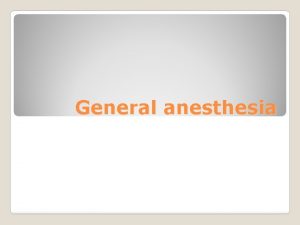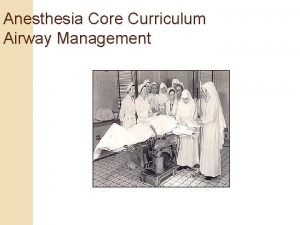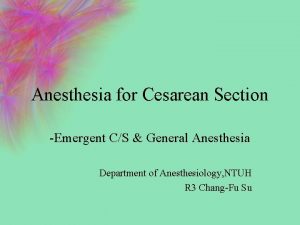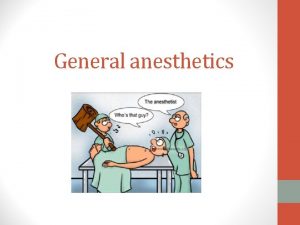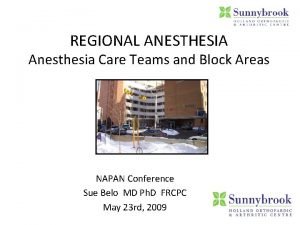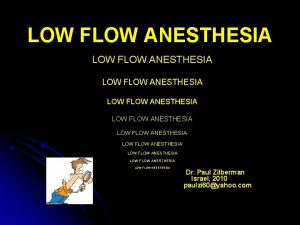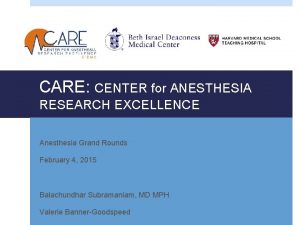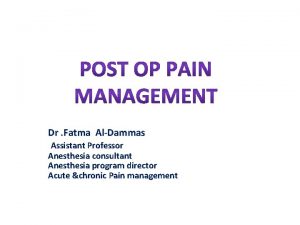General anesthesia General anesthesia is essential to surgical































- Slides: 31

General anesthesia • General anesthesia is essential to surgical practice, because it renders patients analgesic, amnesia, and unconscious reflexes, while causing muscle relaxation and suppression of undesirable reflexes. • No single drug capable of achieving these effects both safely and effectively. • Potent general anesthesia are delivered via inhalation and intravenously. • Anesthesia can be divided into three stages: induction, maintenance, and recovery.


Goals of surgical anesthesia Lüllmann, Color Atlas of Pharmacology – 2 nd Ed. (2000)

General anesthesia • Induction is the period time from onset of administration of the anesthetic to development of effective surgical anesthesia. • General anesthesia is normally induced with an intravenous anesthesia that produce unconsciousness within 1 minute or so. • After that, additional inhalation or intravenous drugs comprising anesthesia. The selected anesthesia combination is given to produce the desired depth of surgical anesthesia • For children, without intravenous access, moderate agent, such as halothane are used to induce general anesthesia.


General anesthesia • Maintenance provides a sustained surgical anesthesia. Usually done by administration of volatile anesthesia, because these agents offer good minute-to-minute control over the depth of anesthesia. • Recovery is the time from discontinuation of the administration of the anesthesia until consciousness and protective physiological reflexes are regained. Recovery is reverse of induction,

Traditional monoanesthesia vs. modern balanced anesthesia Lüllmann, Color Atlas of Pharmacology – 2 nd Ed. (2000) 7

Inhalation anesthetics are not particularly effective analgesics and vary in their ability to produce muscle relaxation; hence if they are used alone to produce general anesthesia, high concentrations are necessary. If inhalation anesthetics are used in combination with specific analgesic or muscle-relaxant drugs the

Regimen for balanced anesthesia Lüllmann, Color Atlas of Pharmacology – 2 nd Ed. (2000) 9


Inhalation anesthesia • Inhaled gases are the core of anesthesia, and are used primarily for the maintenance of anesthesia after administration of an intravenous agent. • No one anesthetic is superior to another under all circumstances. • The potency of inhaled anesthesia is defined quantitatively as median alveolar concentration (MAC).


Inhalation anesthesia • MAC is the minimum alveolar concentration of anesthetic that produces immobility in 50% of patients exposed to a standard noxious stimulus. • MAC is usually expressed as a percentage of gas mixture required to achieve the effect, and is small for potent anesthetics.

Inhalation anesthesia • No specific receptors has been identified as the target of general anesthesia action. • The fact that chemically unrelated compounds produce the anesthesia state argue against the existence of such receptors. • The focus is now on interaction of inhaled anesthetics with proteins comprising ion channels. • For example, the general anesthesia increase the sensitivity of the gama-aminobutyric acid (GABA) receptors to neurotransmitters, GABA, which causes a prolongation of inhibitory chloride ion current after a pulse of GABA release. Postsynaptic neuronal excitability is thus diminished.


Inhalation anesthesia • Other receptors are also effected for example, the activity of the inhibitory glycine receptors in the spinal motor neurons are increased. • In addition, inhalation anesthesia block excitatory postsynaptic current of the nicotinic receptors.

Halothane • Is the prototype to which the newer inhalation anesthetics have been compared. • It has the ability to induce anesthetic state rapidly and to allow quick recovery. • However, with the recognition of series side effect and the availability of other anesthetics that have less complication, halothane is largely being replaced. • Halothane is potent anesthetic, nonetheless it is relatively weak analgesic. Thus, it is co-administrated with Nitrous oxide, Opioids.

Halothane • Halothane produce bronchial smooth muscle relaxation, which make it beneficial for patients with asthma. • Is not hepatotoxic in pediatric patients, and it has a pleasant odor, which make it suitable in children for inhalation induction. • Halothane is metabolized in the body to tissue toxic materials, which may be responsible for the toxic reaction that some patients (specially females) developed after anesthetic. • The reaction begin as a fever followed by anorexia, vomiting, and patient may exhibits sighs of hepatitis.

Halothane • Adverse effect: halothane causes bradycardia. It has undesirable property of causing cardiac arrhythmias. • Halothane produces concentration dependent hypotension. It is recommended that a direct vasoconstrictor such as phenylephrine, be given. • In a very small percentage of patients halothane has the potential to induce malignant hyperthermia.

Enflurane • Is less potent than halothane, but produce rapid induction and recovery. • About 2 % is metabolized to fluoride ion, which is excreted by the kidney, therefore Enflurane is contraindicated in kidney failure patient. • Enflurane exhibit the following differences from halothane: (1) Fewer arrhythmia, (2) less sensitizing the heart to catecholamines, and (3) greater potentiation of muscle relaxants due to more “curare-like” effect. • Disadvantage of Enflurane is that it does cause central nervous system excitation, and so is contraindicated in patients with seizure disorder.

Isoflurane • Is widely used, and little metabolized to fluorine, thus it is not tissue toxic. • It dilates the coronary artery and so may be beneficial for patient with ischemic heart disease. • Does not induce cardiac arrhythmias and does not sensitized the heart to catecholamines. • It does produce concentration dependent hypotension due to vasodilatation. • Has been reported to cause hepatitis, but with a much lower percentage than halothane.

Nitrous oxide • Is a potent analgesic, but a weak general anesthetic (at 80% cannot produce surgical anesthesia). • Therefore, it combined with other potent anesthetic agent to obtained a surgical anesthesia • Is frequently employed at concentration of 30% in combination with oxygen for analgesia, particularly in dental surgery. • Because of its fast uptake from the alveolar gas, Nitrous oxide produce what is called “second gas effect”, which result from the ability of Nitrous oxide to concentrate the halogenated anesthetics (Halothane, Enflurane, Isoflurane) in the alveoli when they are coadministrated,

Nitrous oxide • Main disadvantages is that it has a speed movement, which may retard the oxygen uptake during recovery, thus causing diffusion hypoxia. • It has moderate to no effect on the cardiovascular system and the least hepatotoxic of the inhalation anesthesia.

Intravenous anesthesia • Are often used for rapid induction of anesthesia, which is then maintained with appropriate inhalation agent. • They are rapid induced anesthesia and so must injected slowly.

Barbiturates • Thiopental is a potent but weak analgesics. It is an ultrashort-acting Barbiturate and has high lipid solubility. • Quickly inter the CNS and depress function, often in less than one minute. • It produces short duration of action because its concentration in the CNS decrease quickly below that necessary to produce anesthesia. • Main adverse effects are coughing, chest wall spasm, and bronchospasm (asthmatic patient).

Propofol • Propofol Is an intravenous sedative/hypnotic used in the induction and maintenance of anesthesia, supplementary analgesics is required. • Propofol is widely used and has replaced thiopental as the first choice for anesthesia induction and sedation, because it produces euphoric feeling in the patient and does not cause postanesthetic nausea and vomiting. – Mechanism of action not known but may be through GABA – Hypotension caused mainly by vasodilatation rather than cardiac depression – Non-analgesic – Antiemetic – Reduces cerebral blood flow – Promotes bacterial growth (hence short shelf life of open solution)

Ketamine • A short acting, induced anesthetic. It actually induce a dissociated state in which the patient is unconscious but appears to be awake and does not feel pain. • Provides sedation, amnesia, and immobility. • It stimulate the central sympathetic outflow, which causes stimulation of the heart and increased blood pressure, and cardiac output. • This property is specially beneficial in patients with either hypovolemic or cardiogenic shock, as well as in patient with asthma.

Ketamine • However, this property limited the use of ketamine in the hypertensive or stroke patients. • It is not widely used because it increases cerebral blood flow, and induces postoperative hallucination particularly in adults. • Ketamine is mainly used in children and young adults for short procedure.



 Essential non essential fatty acids
Essential non essential fatty acids Veterinary anesthesia reservoir bag size chart
Veterinary anesthesia reservoir bag size chart General anesthesia drugs chart
General anesthesia drugs chart 2nd gas effect
2nd gas effect General anesthesia drugs dosage
General anesthesia drugs dosage Joint hospital surgical grand round
Joint hospital surgical grand round Lithotomy draping
Lithotomy draping Acute specific surgical infection
Acute specific surgical infection Dusting powder definition in pharmacy
Dusting powder definition in pharmacy Cmr surgical
Cmr surgical Surgical plume evacuator tool
Surgical plume evacuator tool Nasogastrio
Nasogastrio Hematology suffix
Hematology suffix Joint hospital surgical grand round
Joint hospital surgical grand round Hultl
Hultl Stryker scrub cap
Stryker scrub cap A nurse floats to a busy surgical unit
A nurse floats to a busy surgical unit Joint hospital surgical grand round
Joint hospital surgical grand round Tatum surgical
Tatum surgical Qrc surgical
Qrc surgical Fulguration diathermy
Fulguration diathermy Chapter 22 surgical asepsis
Chapter 22 surgical asepsis Surgical phase periodontal therapy
Surgical phase periodontal therapy Suture colour coding
Suture colour coding Joint hospital surgical grand round
Joint hospital surgical grand round Care of critically ill surgical patient
Care of critically ill surgical patient Surgical planning laboratory
Surgical planning laboratory What part of the surgical gown is considered sterile
What part of the surgical gown is considered sterile Voluntary surgical contraception
Voluntary surgical contraception Surgical bandage types
Surgical bandage types Surgical metabolism
Surgical metabolism Aorn surgical hand scrub
Aorn surgical hand scrub



